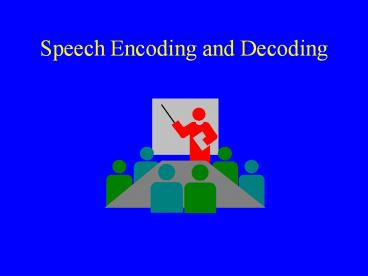Speech Encoding and Decoding PowerPoint PPT Presentation
1 / 36
Title: Speech Encoding and Decoding
1
Speech Encoding and Decoding
2
Senior Design Presentation
- Naveed M. Alam
- Hamidah Hassan
3
Description
- In this project we used Pulse Code Modulation to
digitize analog data (voice) for transmission. - The digitized values are sent to a receiver
program which recreates the original data.
4
Goals of the Project
- The goal of the project was to show that
digitized 8bit representation of the original
voice signal fully recreates the signal at the
receiver side. - Compare the quality of the received signals
having voltage levels represented by 4 and 8bits.
5
What is PCM?
6
Pulse Code Modulation
- Using Pulse Code Modulation Scheme we can divide
an analog signal into equally spaced voltage
levels to be represented in digital form. - The Uniform PCM requires that the step size or
difference between each voltage level remains the
same.
7
(No Transcript)
8
Hardware Apparatus
- We used Motorola 56302 processor to achieve our
project goals. - All software for this project was written in
assembly. - Microphone was used as an input and the output
was directed to speakers.
9
Initial Design
10
Design Low Pass Filter
- Since we are dealing with voice signals for this
project, so it is easy to assume that all the
signals would be sinusoidal signal. - Since most of the human speech takes place
between 0-3000Hz, so a filter was designed to
pass only speech frequencies.
11
Set Reference Values
- Initial design was based upon 4bit
representation. - The reference voltage level 0V and the Digital
Ref 1000.
12
Sorry Couldnt Add whole Design
13
GO TO FINAL PAPER FOR DETAILS
14
Set Backs of Initial Design
- The program was long and cumbersome.
- The DSP processor didnt entertain division
command as we had envisioned. - Dsp required the quotient to be less than 1 which
defeated the whole purpose of our initial design. - We Discovered this when our program didnt work.
15
Why doesnt it work?
16
Final Transmitter Design
- The idea for setting reference value was adopted
from the initial design. - The reference values remained 0v and 1000 for
4bit representation. - Two look up tables were made
- 1) Greater
- 2) Less
17
Final Design
- Since the DSP didnt recognize -1 or 1 values in
fraction form so the highest value for 4bits was
.875V and lowest was -.9908V(randomly chosen). - For 8bits the lowest value was -.9984V and the
highest value was .9906V. - For any value above the highest or lower than the
lowest DSP output is set to 0.
18
Back to Transparencies
19
GO TO FINAL PAPER FOR FIGURES AND TABLES
20
Design Testing
- Both 4bit and 8bit designs were tested by a file
which contained random values between 1 and -1. - The wave form generated was seen on scope.
- We sent sinusoidal signals through the DSP and
recreated signal was shown on the Oscilloscope.
21
Results of Testing
- 8bit transmitting and receiving scheme generates
a comprehendible voice signal. - 4bit transmitting and receiving scheme generates
non comprehendible voice signal.
22
IDEAS
23
Ideas for Extension of this project
- We can run transmitter and receiver programs on
two different DSP processors with little
modifications. - This will allow us to make one DSP a transmitter
and the other a receiver
24
IDEAS
- Can send data back and forth between two DSP
processors by running a whole transmitter
receiver program on each.
25
Conclusion
- We were able to achieve our goal of simulating
that 8bit representation did provide us with the
original signal in complete form. - Our initial idea of simulating this process using
2 DSP processors was not achieved because of time
constraints.
26
Practical Use of this Idea
- PCM was introduced in 1930s and was incorporated
into the communication industry in 1960s with and
advent of semiconductor devices. - Most of our telephone lines use this scheme to
transmit and receive data.
27
(No Transcript)
28
(No Transcript)
29
Tables
30
(No Transcript)
31
(No Transcript)
32
(No Transcript)
33
Set Reference values
34
(No Transcript)
35
(No Transcript)
36
(No Transcript)

